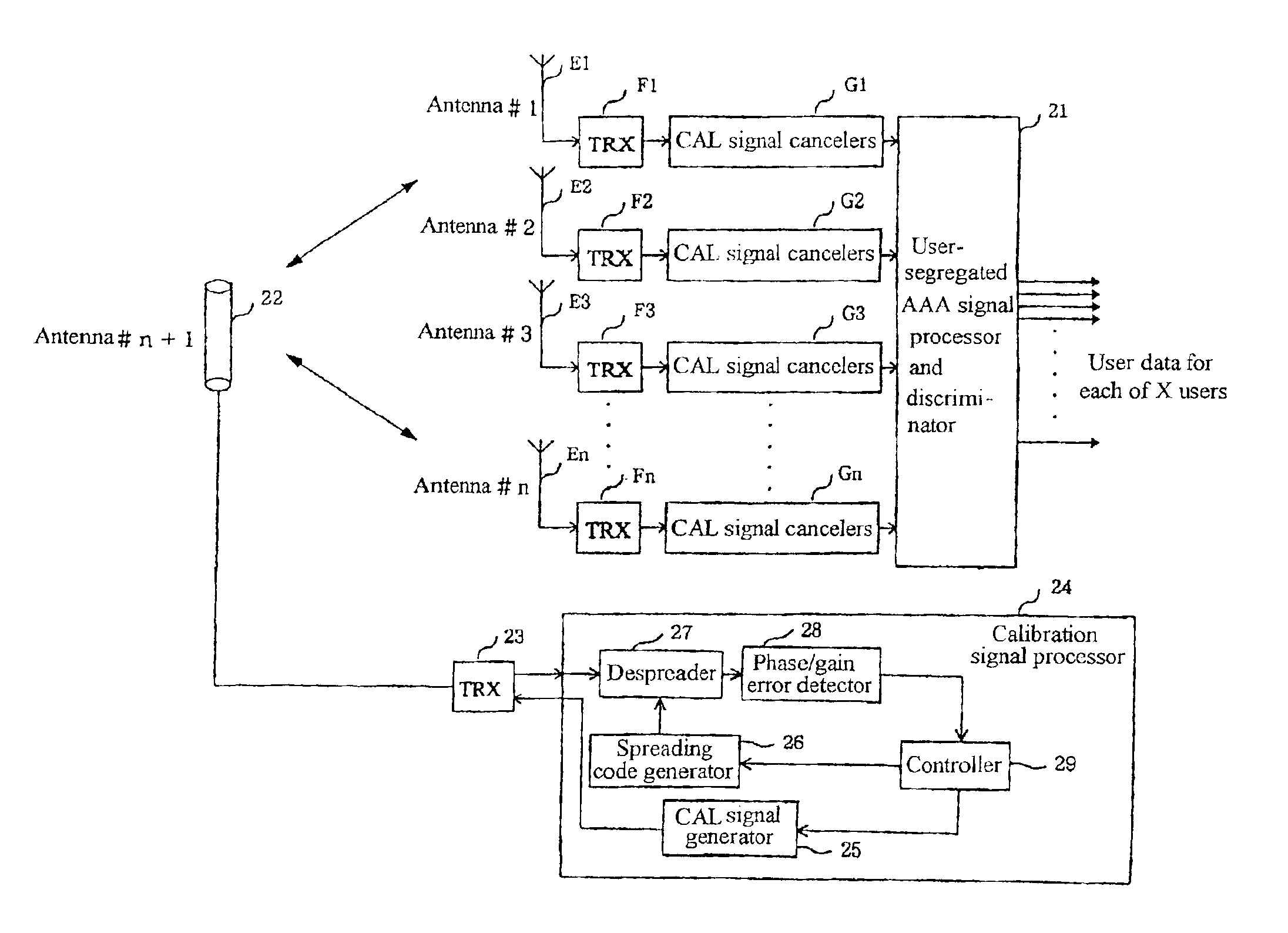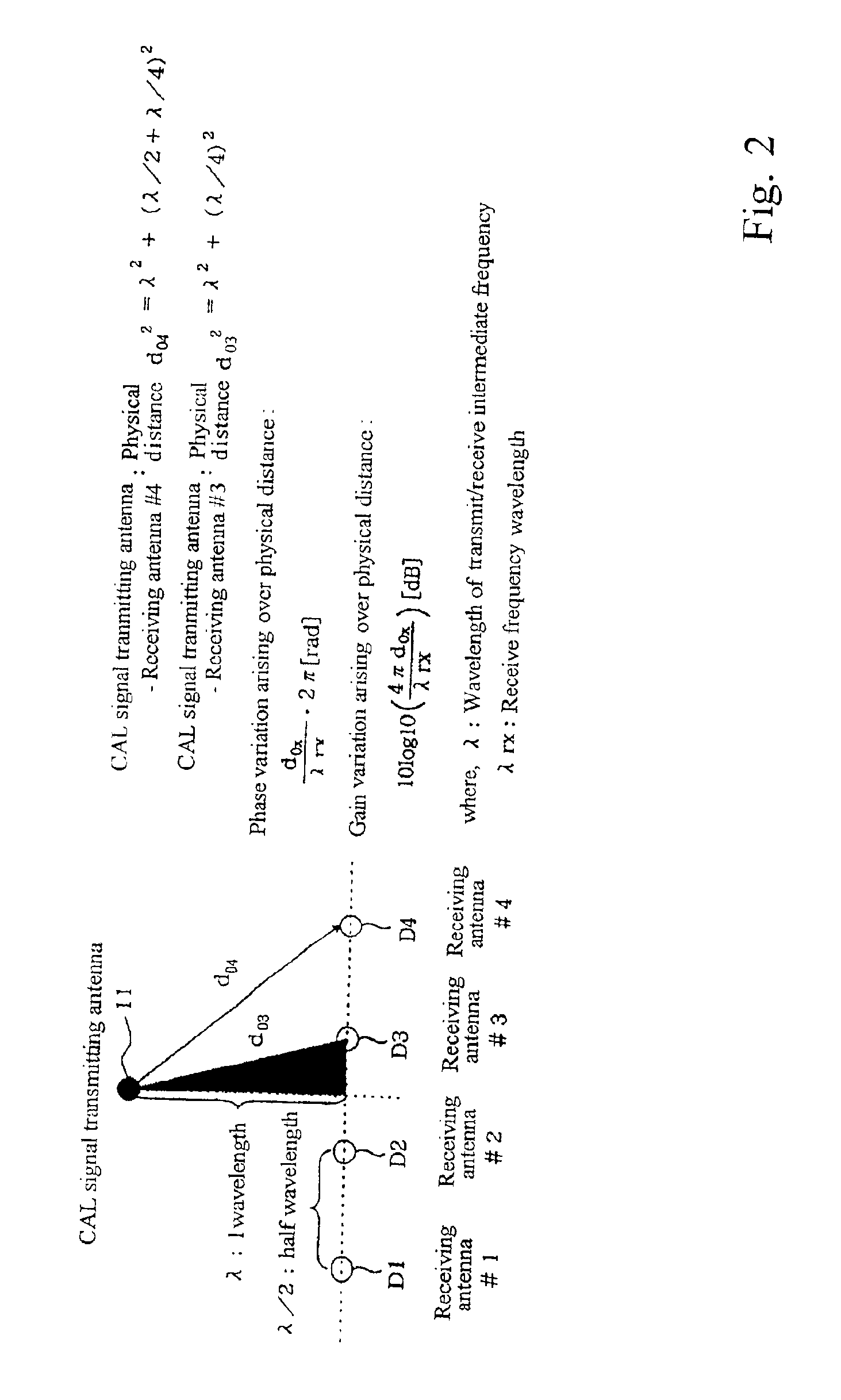Communication device
a communication device and antenna directivity technology, applied in the field of communication devices, can solve the problems of circuit components not operating, the detection of the mobile station in the 45-degree direction cannot be relied on from the start, and the actual inability to impart high antenna directivity, so as to improve the reception quality of the communication signal, reduce interference, and raise calibration efficiency
- Summary
- Abstract
- Description
- Claims
- Application Information
AI Technical Summary
Benefits of technology
Problems solved by technology
Method used
Image
Examples
first embodiment
[0072
[0073]A CDMA base station according to a first embodiment of the present invention will now be explained with reference to the drawings.
[0074]The processing when using a communication antenna to receive and transmit communication signals in the first embodiment is similar to what was explained earlier with reference to FIG. 6 regarding the prior art. In the following, therefore, only the points that characterize the CDMA base station of this embodiment will be explained in detail and points similar to those set out with reference to the prior art example of FIG. 6 will be omitted or discussed only briefly.
[0075]FIG. 1 shows the configuration of the CDMA base station of the first embodiment. The CDMA base station comprises n number of communication (transmission / reception) antennas A1-An constituting an adaptive array antenna, n number of transceiver units (TRX) B1-Bn, and n number of calibration signal (CAL signal) cancellers C1-Cn. The communication antennas A1-An, transceiver...
second embodiment
[0118
[0119]A CDMA base station according to a second embodiment of the present invention will now be explained with reference to FIG. 3.
[0120]FIG. 3 shows the configuration of the CDMA base station of the second embodiment. The second embodiment differs from the first embodiment of FIG. 1 in that, for example, it is provided with calibration signal transmitting capability. Constituent elements similar to those of the first embodiment include n number of communication (transmit / receive) antennas E1-En constituting an adaptive array antenna, D number of transceiver units (TRX) F1-Fn, n number of calibration signal (CAL signal) cancellers G1-Gn. Similar to the first embodiment, the communication antennas E1-EN, transceiver units F1-FN and CAL signal cancellers G1-GN are combined in sets so as to form n number of communication antenna chains. The CDMA base station of the second embodiment is also equipped with a user-segregated AAA signal processor and discriminator 21 which is common t...
third embodiment
[0152
[0153]A CDMA base station according to a third embodiment of the present invention will now be explained with reference to FIG. 4.
[0154]The explanation of the third embodiment will be extended to include configurational details of the transceiver units of the communication antenna chains discussed regarding the first and second embodiments and configurational details of the CAL signal transceiver unit of the second embodiment. For simplicity of description, the third embodiment will be explained with reference to a configuration having an adaptive array antenna comprising four communication antennas H1-H4.
[0155]The configuration of the CDMA base station of the third embodiment is shown in FIG. 4. This CDMA base station is equipped with four communication (transmission and reception) antennas H1-H4 constituting an adaptive array antenna, four duplexers (DUP) I1-I4 that function to separate the transmission / reception chains by filtering, four receiver (RX) units J1-J4 and four tr...
PUM
 Login to View More
Login to View More Abstract
Description
Claims
Application Information
 Login to View More
Login to View More - R&D
- Intellectual Property
- Life Sciences
- Materials
- Tech Scout
- Unparalleled Data Quality
- Higher Quality Content
- 60% Fewer Hallucinations
Browse by: Latest US Patents, China's latest patents, Technical Efficacy Thesaurus, Application Domain, Technology Topic, Popular Technical Reports.
© 2025 PatSnap. All rights reserved.Legal|Privacy policy|Modern Slavery Act Transparency Statement|Sitemap|About US| Contact US: help@patsnap.com



